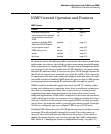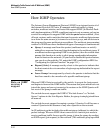
Multimedia Traffic Control with IP Multicast (IGMP)
CLI: Configuring and Displaying IGMP
Configuring Per-Port IGMP Traffic Filters.
Syntax: vlan < vid > ip igmp [auto < port-list > | blocked < port-list > |
forward < port-list >]
Used in the VLAN context, this command specifies how each
port should handle IGMP traffic. (Default: auto.)
Note: Where a static multicast filter is configured on a port,
and an IGMP filter created by this command applies to the
same port, the IGMP filter overrides the static multicast filter
for any inbound multicast traffic carrying the same multicast
address as is configured in the static filter. (Refer to the section
titled “Filter Types and Operation” in the “Port Traffic
Controls” chapter of the Management and Configuration Guide
for your switch.
For example, suppose you wanted to configure IGMP as follows for VLAN 1
on the 100/1000T ports on a module in slot 1:
Ports A1-A2 auto Filter multicast traffic. Forward IGMP traffic to hosts on these
ports that belong to the multicast group for which the traffic is
intended. (Also forward any multicast traffic through any of
these ports that is connected to a multicast router.)
Ports A3-A4 forward Forward all multicast traffic through this port.
Ports A5-A6 blocked Drop all multicast traffic received from devices on these ports.
Refer to the table below in the section on “Automatic Fast-Leave IGMP” for a
description of the default behavior of data-driven switches.
Depending on the privilege level, you could use one of the following com-
mands to configure IGMP on VLAN 1 with the above settings:
ProCurve(config)# vlan 1 ip igmp auto a1,a2 forward a3,a4
blocked a5,a6
ProCurve(vlan-1)# ip igmp auto a1,a2 forward a3,a4 blocked
a5,a6
The following command displays the VLAN and per-port configuration result-
ing from the above commands.
ProCurve> show igmp vlan 1 config
2-10


















